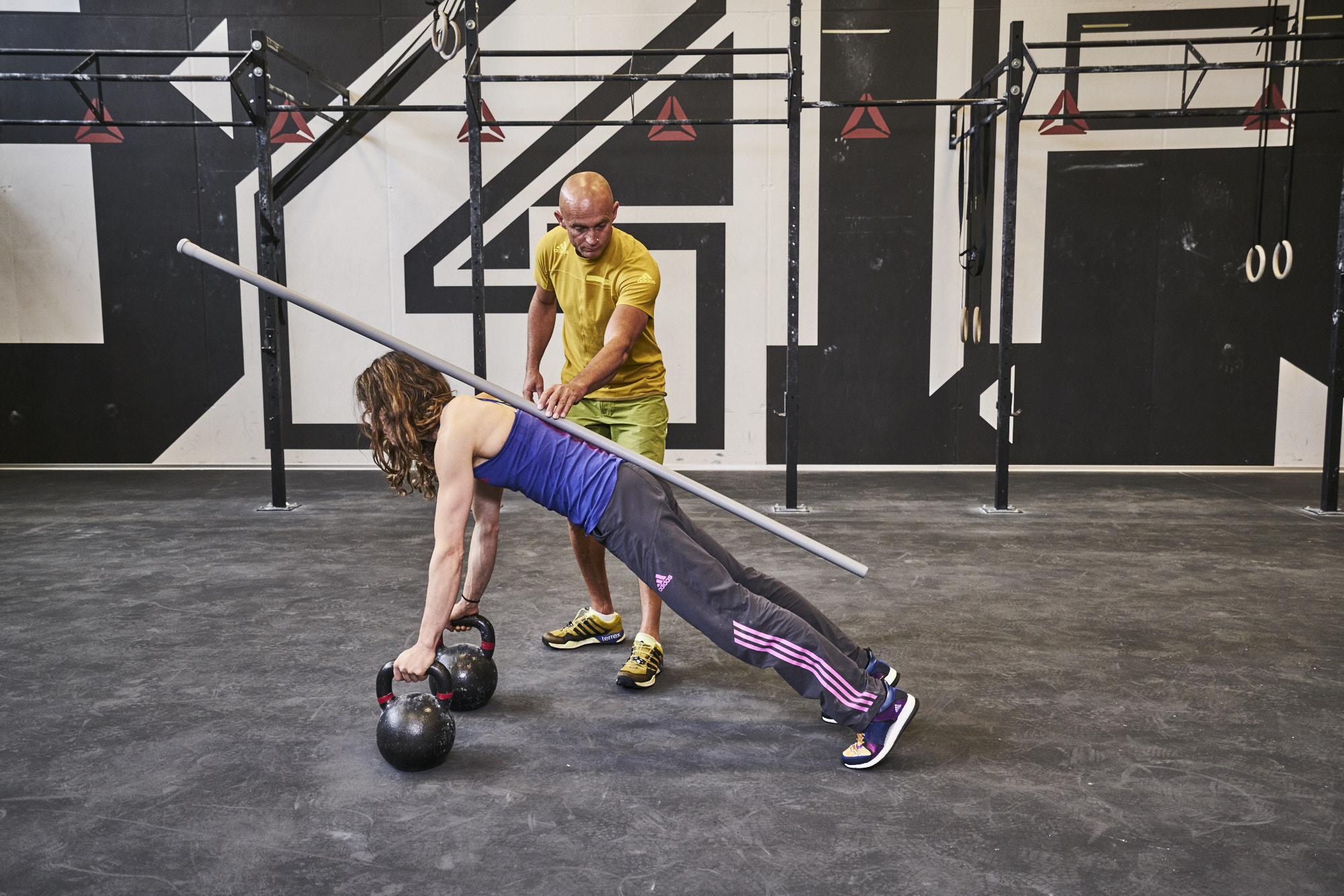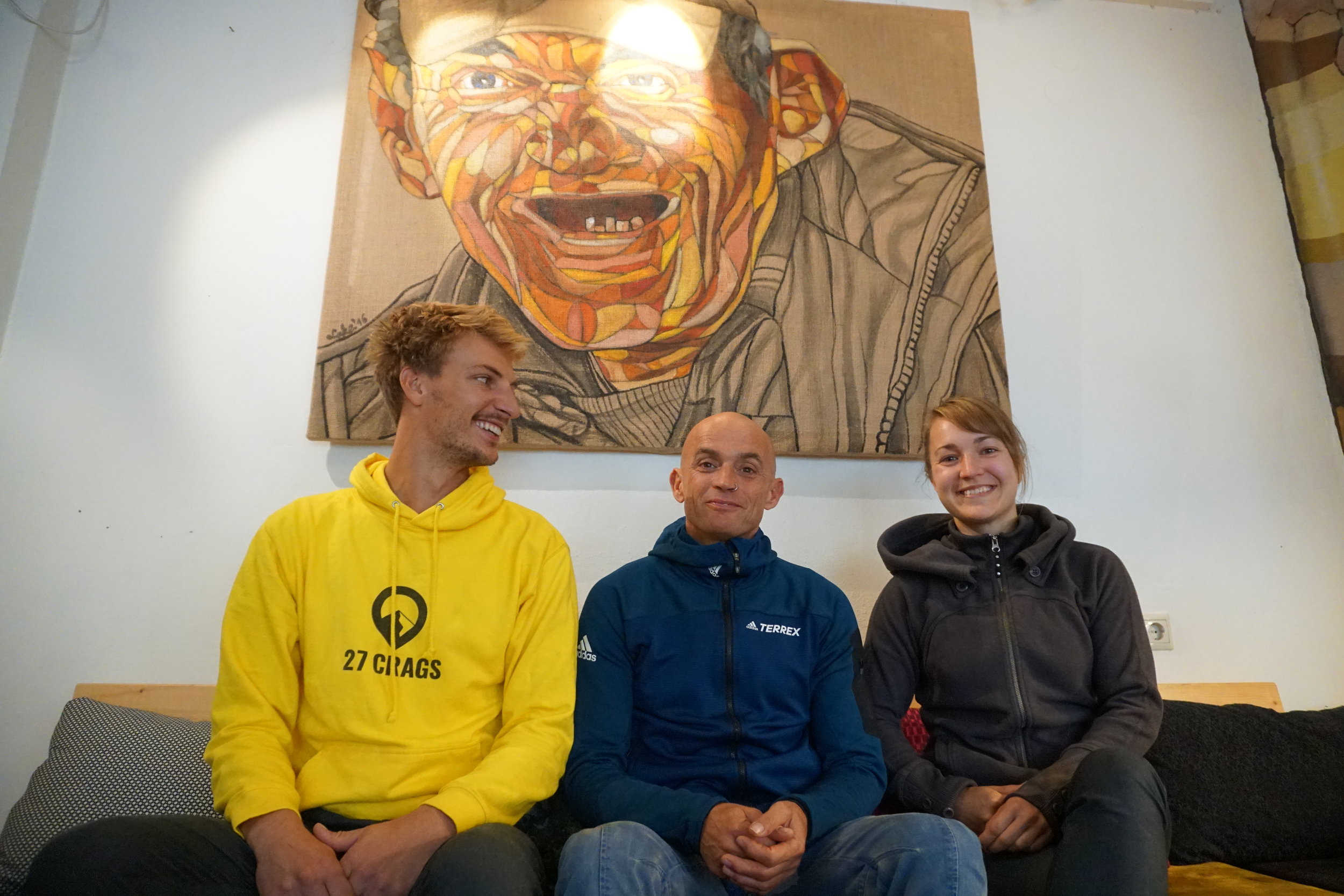Training for climbing should be hard but not difficult
The author of Gimme Kraft and the coach of Alex Megos shares his secrets
As climbing is increasing in popularity and the bar being raised by climbers like Adam Ondra, Nalle Hukkataival, and Angy Eiter, many are looking into ways to improve their climbing. We were more than curious to hear the thoughts of Dicki Korb, Alex Megos’ coach and the author of one of the most sold climbing training books “Gimme Kraft”. What is the magic ingredient that gets you to the next level?
FIND CRAGS NEAR YOU EASILY
Create your free account to 27 Crags and get free trial of .premium with hundreds of guidebooks, including Fontainebleau, Kalymnos and Albarracín!
A while ago we ran into Dicki and Alex when they were climbing, just like us but ‘a bit’ harder, at sector Mars in Leonidio. They had been invited to the local climbing festival and Dicki was happy to take some time for a chat about his coaching principles and climbing in general.
When meeting later in a cozy cafeteria, we have barely taken seats before finding ourselves in a two hour conversation about coaching principles, training tips, motivation, sponsors, and much more. Here are the best pieces!
Dicki training with Mélissa Le Nevé.
The Prodigy
When talking with Dicki it’s impossible to avoid talking about his most known athlete Alex Megos - a young phenomena who jumped under the spotlights after being the first person to onsight a 9a when he was only 19 years old. These two have already 11 years of climbing history together. When seeing them having fun at the crag it’s easy to tell that they get along more than well.
“The story began when Alex was 13 years old and came to our Cafe Kraft gym for the first time. My counterpart Patrick Matros and I immediately saw that Alex wasn’t normal.” And Dicki means this in a good way. “He was just extremely motivated to climb. We hadn’t seen anything like it before.” This was a start of a relationship where Dicki and Patrick took him under their wing and step by step began to develop his climbing.
Alex kept on getting stronger and when he managed the first ever 9a onsight there was no doubt that the whole climbing world would know his name. This, together with the fact that the Cafe Kraft gym had opened just one year before and the Gimme Kraft book was published about two months after the achievement, led to an overwhelming attention from climbers around the world: “Suddenly everyone wanted to train with us.”
This combination not only brought a lot of climbers knocking behind their door, but also helped to form a partnership with Adidas to start training with their athletes such as Sasha DiGiulian and Mélissa Le Nevé. This also allowed Dicki to focus mainly on coaching and take a step back from his former profession as a social worker - although the skills needed in his previous job might not be that far away from those needed in coaching climbers.
It’s all about personalization
One prevalent theme in Dicki’s coaching style is personalized programs. When it comes to training, there is no one-size-fits-all solution. “This is the reason we stopped group practices for the German national team. People need personalized support and coaching them all at the same time simply doesn’t work.“
Some climbers come to Dicki only sporadically or even for just one session. How do you manage to make personal programs when given such a limited time?
“I always start with an open discussion in order to understand the whole picture. How do the climbers see themselves, what do they think about climbing and training, what’s their job, and how does their life look like in general. What I also always ask is what they want from me and how they think I can help them. This usually gives a good overview of the situation and about their goals and wishes.”
When talking about different skills and unique individuals, Dicki mentions a set of tests which both Adam Ondra and Alex Megos took. The differences between them were massive. “From my point of view climbing is not measurable. Everyone’s so different and so is their climbing.”
“I need more power!” Probably each of us has either said this or heard it after a failed attempt on a route. This is also what many people come to Dicki for: everyone wants to be stronger, especially from the fingers. “I would say 85 % of the time it’s not about power. What is way more common are tactical problems. People might have 5h sessions at the gym but they are not doing it efficiently. Trying problems is not training, it’s climbing. In training you have other goals than getting to the top.”
Another factor Dicki pays a lot of attention to in his coaching is the health and wellbeing of climbers, both mentally and physically. There is one trend that hits especially professional climbers which he doesn’t like. “Shoulder injuries are nowadays a big problem especially in bouldering and in competition climbing. The routes are built for the show and the media which means that often the safety of routes is ignored. Some examples are crazy dynos and iron cross type of moves between slopers where the whole body weight lays on the ligaments, not muscles. It’s just horrible for the body.”
How can we change this unhealthy trend? Dicki gives one simple but great tip for all gym owners, route setters, and competition coordinators: “Bring a doctor or a physiotherapist to check the routes beforehand to avoid unhealthy moves on the competition problems. World Cup would be an obvious starting point.”
Mental Game
Climbing has already a built-in mental game when it comes to heights and falling. Many of us get intimidated every now and then, and overcoming those situations gives this sport one of its unique features. The mental aspect of this shared passion of ours manifests in plenty of other ways too when it comes to training.
You know those days when you don’t feel like climbing at all but force yourself to go anyway because you’re afraid that your progress might be hindered? When you’re paid to climb it goes into a whole new level. “There’s a big difference in going to the gym because you want to compared to feeling like you simply have to. What about my sponsors? I have to climb and be strong, it’s my job! Even when athletes are ill or in pain they feel obligated to climb. It’s really tricky!”
Dicki has also witnessed lack of motivation among (non-professional) climbers who came to him for a short coaching period. You might think these people are pumped up and driven to train when meeting Dicki - in the end they paid for it - but that doesn’t always seem to be the case.
“There was one group of people who were just really anemic during the whole coaching session. They weren’t excited about climbing at all and seemed like they had just fixed their minds into reaching a specific grade. After chatting with them for a while I simply suggested them to stop climbing.” This of course surprised the whole group. “Climbing should be something one enjoys doing. It doesn’t make sense to force oneself to do it continuously if it always feels bad.” So what was the result? The climbers took Dicki’s advice and had a few months break from climbing. Afterwards they were highly motivated again and were able to achieve the goals they had been pursuing for a long time.
Next time you’re seriously lacking motivation it’s also worth considering if a break would help. You might be surprised about the results. As Dicki puts it: “A good climber wants to climb."
The Magic Ingredient
Even though climbing is a very social sport and often in competitions everyone is genuinely cheering for each other, sharing hasn’t always been the name of the game in coaching. “Climbers proactively coming to us to learn is something very new we have seen during the past two years. Before the ruling mentality was that one needs to learn himself. This was also prevalent among coaches! There wasn’t much information sharing and people felt like they had secrets to protect.”
Everyone is dreaming about finding the magic ingredient that will take their, or their athlete’s climbing to the next level - whether it’s hangboard, MoonBoard, campusing or amulets. It’s tempting to think that professional climbers have knowledge that others are missing. Dicki shoots down these claims immediately: “I can tell you, there are no secrets!”
But there must be something that differentiates the pros from the mainstream?
“I have seen a lot of strong, professional climbers. But only few of them have this outstanding will to climb. You can see this craziness in their eyes when they push for the moves others find impossible. Their eyes pop out and you can tell that they are giving 110% when others leave it to 99,9%. The only reason they might not be able to finish a route is that they are too weak. It’s not the friction, the weather, the high gravity, the wound in the pinky, or anything else.”
“This is Alex. It’s always horrible to have a photo shoot or to film with him because he just wants to climb. The filmmaker or photographer has just one chance on a route. If Alex sends it, he’s not going to climb it again even if it would be needed for the film. He wants to climb another route. He’s extremely motivated to climb, not about being on the spotlight. Even rest days are always problematic. You really have to stop him from climbing”
Versatility over complexity
Even if there is no magic bullet that will make one a better climber, Dicki has some favorite exercises to share. These are familiar to those who have read the Gimme Kraft book. “Rings are great. You can adjust the level and they are always in motion. And this kind of movement is what happens in climbing too.”
Dicki Korb in a cafeteria in Leonidio and Tim and Hanna from 27 Crags next to him.
Another one is the specific training wall that can be found in many bouldering gyms. It’s usually put a bit to the side and doesn’t have those tempting obvious routes but rather a splash of holds all over. “A 45-degree overhanging wall with small footholds, and you don’t need more for training bouldering. The colour set routes don’t really train you for competition nor outdoors. Overall, there’s no need for anything fancy in order to get strong. All you need is a bit of knowledge and plenty of motivation. What we are currently seeing is that these small walls people used to have in their cellars are coming back. Strong climbers are going back to the caves.”
Compared to many other sports, climbing has an incredible amount of layers and it’s extremely complicated. “Have you ever seen a route which looks like a hangboard? The muscle system in climbing is so complex, which means that your training needs to be extremely versatile. I’ve seen amazingly strong climbers doing crazy things on a campus board, but when they go on the wall it looks like their whole upper body is detached from the lower part. You need the connection all the way from the tip of your toes to the edges of your fingers.”
Even though Dicki repeatedly underlines that climbing is complex, it sounds a bit surprising when he suddenly says that training itself doesn’t need to be. “If you need more sloper power, train with slopers. More crimp power? Train with crimps. Training is not as hard as people think!”
Training is not so hard. That sounds good.
__________
Summary
Keep that motivation up by not taking climbing too seriously and remembering to have fun.
You don’t need fancy equipment to get strong - one shouldn’t make training too difficult.
It’s tempting to train only power but that's often not the right focus to get the best results. Paying attention to the tactics and focusing on technique might give much better results.
Want to know more about Dicki’s training methods? Check out the awesome Gimme Kraft website. Or you want to book a coaching with him? Feel free to contact them directly at coaches at kraftfactory.de
___________
Eager to get that strength in use outdoors? Get a free trial to hundreds of guidebooks and join the community of tens of thousands of climbers by signing up here for free!
Text by Hanna Vartia, who's working as a marketing manager @27 Crags and prefers her rock 5 meters high.
27 Crags topos are made by local climbing area developers and enthusiasts. From the .premium subscriptions 50% of the income will go straight to the topo authors who are doing extremely important job in developing the climbing areas.
Interested in making topos? Don't hesitate to send us an email: tim(at)27crags(dot)com










